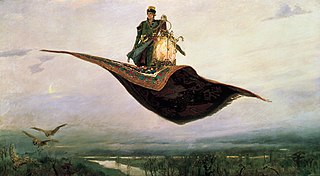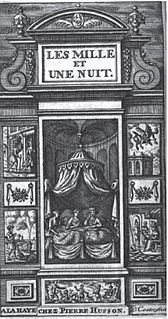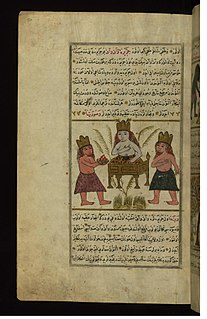 W
WReligion in pre-Islamic Arabia included indigenous Arabian polytheism, ancient Semitic religions, Christianity, Judaism, and Iranian religions such as Zoroastrianism, Mithraism, and Manichaeism.
 W
WAtlantis of the Sands refers to a legendary lost city in the southern deserts of the Arabian Peninsula, thought to have been destroyed by a natural disaster or as a punishment by God. The search for it was popularised by the 1992 book Atlantis of the Sands – The Search for the Lost City of Ubar by Ranulph Fiennes. Apart from English name, coined by T. E. Lawrence, the city is commonly also called Ubar, Wabar or Iram.
 W
WThe Bab-el-Mandeb is a strait between Yemen on the Arabian Peninsula, and Djibouti and Eritrea in the Horn of Africa. It connects the Red Sea to the Gulf of Aden.
 W
WThe Book of the Thousand Nights and a Night (1885), subtitled A Plain and Literal Translation of the Arabian Nights Entertainments, is an English language translation of One Thousand and One Nights – a collection of Middle Eastern and South Asian stories and folk tales compiled in Arabic during the Islamic Golden Age – by the British explorer and Arabist Richard Francis Burton (1821–1890). It stood as the only complete translation of the Macnaghten or Calcutta II edition of the "Arabian Nights" until the Malcolm C. and Ursula Lyons translation in 2008.
 W
WThe Kitab al-Bulhan, or Book of Wonders, or Book of Surprises, is a mainly 14th century Persian manuscript compiled – and possibly illustrated – by Abd al-Hasan Al-Isfahani. The codex was probably bound during the reign of Jalayirid Sultan Ahmad (1382-1410) at Baghdad, and includes texts on astronomy, astrology, geomancy and a section of full-page illustrated plates dedicated to each discourse topic, e.g. a folktale, a sign of the zodiac, a prophet, etc.
 W
WJuma and the Magic Jinn is a children's picture book written by Joy Anderson and illustrated by Charles Mikolaycak. First published in 1986, this folktale with an African setting tells the story of a fictional, daydreaming boy named Juma who is living on the real Lamu Island just off the East coast of Kenya. Desiring to be some place where he won't have to study or behave, Juma seeks the help of a magical jinn, a decision which leads Juma on misadventures. In the same year the book was published, Juma and the Magic Jinn won a 1986 Golden Kite Award for Mikolaycak's illustrations. These illustrations additionally played a role in Mikolaycak receiving the 1987 Kerland Award "in recognition of singular attainments in the creation of children's literature."
 W
WThe Karkadann is a mythical creature said to have lived on the grassy plains of India and Persia.
 W
WKuyūthā is the cosmic bull in medieval Islamic cosmography. It is said to carry on its back the angel who shoulders the earth and the rock platform upon which the angel stands. The bull is said to stand on the giant fish or whale, Bahamut.
 W
WA magic carpet, also called a flying carpet, is a legendary carpet and common trope in fantasy fiction. It is typically used as a form of transportation and can quickly or instantaneously carry its users to their destination.
 W
WA mellified man, or a human mummy confection, was a legendary medicinal substance created by steeping a human cadaver in honey. The concoction is detailed in Chinese medical sources, including the Bencao Gangmu of the 16th century. Relying on a second-hand account, the text reports a story that some elderly men in Arabia, nearing the end of their lives, would submit themselves to a process of mummification in honey to create a healing confection.
 W
WAl-Mi'raj or Almiraj is a mythical beast said to live on a mysterious island called Jazirah al-Tennyn within the confines of the Indian Ocean. It takes the form of a rabbit with a unicorn-like horn or horns. According to legend, the beast was a gift given to Alexander the Great from the inhabitants of the island after he killed a large dragon that had been eating the livestock of the people there. It is mentioned in Zakariya Ibn Muhammad Al-Qazwini's Marvels of Things Created and Miraculous Aspects of Things Existing.
 W
WLes mille et une nuits, contes arabes traduits en français, published in 12 volumes between 1704 and 1717, was the first European version of The Thousand and One Nights tales.
 W
WMount Qaf, or Qaf-Kuh, also spelled Cafcuh and Kafkuh, or Jabal Qaf, also spelled Djebel Qaf, or Koh-i-Qaf, also spelled Koh-Qaf and Kuh-i-Qaf or Kuh-e Qaf is a legendary mountain in the popular mythology of the Middle East. In Islamic tradition, Mount Qaf is said to be the homeland of the jinn and was made out of shining emerald by God.
 W
WOne Thousand and One Nights is a collection of Middle Eastern folk tales compiled in Arabic during the Islamic Golden Age. It is often known in English as the Arabian Nights, from the first English-language edition, which rendered the title as The Arabian Nights' Entertainment.
 W
WPicatrix is the name used today for a 400-page book of magic and astrology originally written in Arabic under the title Ghāyat al-Ḥakīm, which most scholars assume was originally written in the middle of the 11th century, though an argument for composition in the first half of the 10th century has been made. The Arabic title translates as The Aim of the Sage or The Goal of The Wise. The Arabic work was translated into Spanish and then into Latin during the 13th century, at which time it got the Latin title Picatrix. The book's title Picatrix is also sometimes used to refer to the book's author.
 W
WShams al-Ma'arif or Shams al-Ma'arif wa Lata'if al-'Awarif is a 13th-century grimoire written on Arabic magic and a manual for achieving esoteric spirituality. It was written by The Algerian scholar Ahmad al-Buni who wrote it while living in Ayyubid Egypt, he died around 1225 CE. The Shams al-Ma'arif is generally regarded as the most influential textbook of its type in the Arab world, and is arguably as important as, if not more than, the Picatrix in both hemispheres.
 W
WSpeak, Bird, Speak Again: A book of Palestinian folk tales is a book first published in English in 1989 by Palestinian authors Ibrahim Muhawi and professor of sociology and anthropology at Bir Zeit University Sharif Kanaana.
 W
WAl-Wakwak, also spelled al-Waq Waq, Wak al-Wak or just Wak Wak, is the name of an island, or possibly more than one island, in medieval Arabic geographical and imaginative literature.